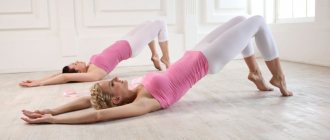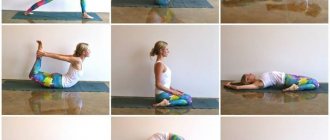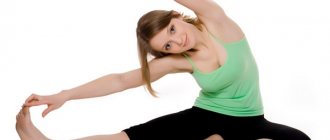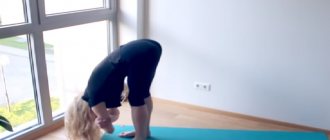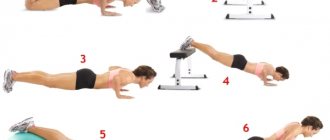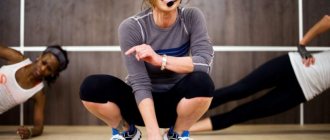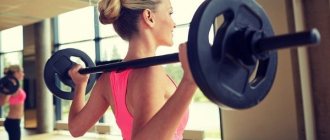Pool lesson plan
Schedule
First of all, it should be noted that there is no universal training scheme - it all depends on the individual characteristics, capabilities and goals of each person.
If you come up with an “average” recommended lesson plan for beginners, it might look like this:
- number of workouts: 3 times a week;
- duration: 30-60 minutes;
- what to do: establishing technique, developing endurance, strength and speed qualities (see more below).
Intensity
Attention: prolonged exercise at too high a pulse is harmful to the heart!
We wrote in detail about the negative consequences of acidification of the heart muscle here.
Therefore, you should definitely monitor your heart rate - calculate your maximum allowable heart rate (220 minus your age), and take 50-80% of it and not exceed this level, or also calculate your heart rate using the Karvonen formula (all given in the same article).
Strength exercises
If you want to swim fast and achieve serious results, then in addition to training in the water, training for swimmers on land is also recommended - in order to prepare the corresponding muscle groups involved in swimming.
This video explains it very well:
For whom are Kifut exercises suitable?
Despite the fact that the exercises were originally developed for training professional swimmers, they are successfully used not only in sports, but they are also prescribed for medical reasons. They can be performed at any age. Kifut exercises are great for:
- Professional athletes in any sport.
- Newcomers to the sport.
- People who care about their figure.
- Children and adults with disorders of the musculoskeletal system and spinal curvature.
Average level
Breath control and endurance
Distance – 900 meters, freestyle training:
- warm-up 2 x 100 meters with one break in the middle;
- 4 x 25 fast crawl with 30 seconds rest between segments;
- 4 x 50 with three strokes on each stroke and a 15-second rest after every 50 meters;
- 4 x 25 fast with holding your breath during the segment and a 30-second rest after;
- 4 x 50 with three strokes on each stroke and a 15-second rest after each half hundred;
- cool down 100 meters.
All styles
Distance – 900 meters, plan:
- warm-up with crawl 2 x 100 with rest at your discretion;
- 4 x 25 on the back with breaks of 15 seconds;
- 4 x 25 breaststroke with breaks;
- 4 x 25 butterfly with breaks;
- 2 100 in turn - 25 in each style with a break of 30 seconds after a hundred;
- cool down with freestyle 200 meters.
Krol + complex
Distance – 1000 meters, plan:
- warm-up 200 without a break;
- 4 x 50 freestyle with alternating speeds every 25 meters and resting for 15 seconds;
- 4 x 100 alternately - 25 meters in each style with a break of 30 seconds after a hundred;
- cool down 200 meters.
Krol + complex No. 2
Distance – 1000 meters, plan:
- warm-up with freestyle 100 meters without a break;
- 4 x 50 alternately butterfly and crawl every 25 meters and a 30-second break after every 50 meters;
- 4 x 50 – back and crawl;
- 4 x 50 – breaststroke and crawl;
- 4 x 50 freestyle with alternating speeds every 25 and rest;
- 100 meter freestyle cool down.
Endurance, breathing rhythm, turning technique
Option 1
Distance – 1200 with added turns, plan:
- warm-up crawl 300 meters without rest;
- 4 x 50 freestyle with alternating breathing - inhaling on the 4th stroke in the first 25 meters and on the 2nd stroke in the next 25 meters with a rest of 15 seconds;
- 200 freestyle followed by 10 turns after every second stroke;
- 4 x 50 in any style at your discretion with a break;
- 300m freestyle cool down.
Option 2
Distance – 1200 with added turns, plan:
- warm-up crawl 200 without rest;
- 200 freestyle followed by 4 turns after every fourth stroke;
- 4 x 100 freestyle, inhaling on the fourth stroke and resting 15 seconds after the segment;
- 4 turns after every fourth stroke;
- 4 x 50 in any style at your discretion with a short break;
- cool down 200 meters freestyle.
How to increase crawl speed
Wayne Goldsmith - famous American swimming coach
Here are five recommendations for increasing speed from Wayne Goldsmith:
- Reducing the time between swimming with your usual style and on your feet (Killer Kick Set).
Consists of two parts:- Finding the speed limit - to do this, you need to swim 50 meters in style and add 15 seconds , then swim this distance on your feet in less total time, after which you should subtract one second at a time and try to swim out of the set time .
When the swimmer touches the side at exactly the set time, the limit will be reached.
Training at the speed limit - swim 8 x 50 on your feet at the established speed limit, allotting two minutes for each segment with a break.
- Finding the speed limit - to do this, you need to swim 50 meters in style and add 15 seconds , then swim this distance on your feet in less total time, after which you should subtract one second at a time and try to swim out of the set time .
- Improving times with shorter distances (Over/Under Set) . The point is to overcome the best old time indicator by dividing the training into shorter segments, gradually reducing the time for each distance.
- Stroke increase combination (8-10-12-14-16). The idea is to do a certain number of powerful strokes at the start, then swim the segment at a slower pace. Following this combination, the swimmer must do:
- in the first segment - 8 powerful strokes and a calmer pace until the end;
- on the second segment - 10 and then, as on subsequent segments, similarly more calm;
- on the third segment – 12
- on the fourth – 14;
- on the fifth – 16;
- 100-200 meters cool down.
- Competitive exercise in pairs (Dive Cones) . The idea is to cover a larger distance in a specified period of time. That is, the swimmer’s goal is to swim a set number of segments in less time than the opponent. As stated sets, you can take 5 segments of 10 seconds, 4 of 15, 3 of 20, 2 of 25.
- Overcoming segments of 60 meters at maximum speed (Super Sixties) . This distance is considered the best for developing the speed qualities of a swimmer. As a training program, you can use the 6 to 60 option with relaxing swimming between speed segments.
It is recommended to repeat the program a couple of times, and you can choose the combination of strokes yourself.
Warm-up
Complex No. 1: Perform each exercise twice, 12 repetitions.
Complex No. 2: Perform each exercise twice, 12-16 repetitions.
Set #3: Do 3 rounds of 8 reps of each of the 3 exercises.
Set #4: Perform each of the 6 exercises twice for 12 reps.
What to drink during exercise?
As with other aerobic exercise, a person loses fluid while swimming .
At the same time, its losses are not so great compared to running and swimming - this is due to the fact that during swimming a person experiences additional cooling due to the water surrounding him.
However, as fluid losses occur, it is recommended to replenish them .
There is no single approach here, but in general you can adhere to the following :
- a few small sips from it during your training . Don't drink too much – Your body doesn't lose as much fluid during low-intensity exercise, and excess water in your stomach can cause discomfort.
- If you have a more intense workout (but still not exhausting), then you can also drink water, just in a little more quantity .
- If you have an intense, long and exhausting workout, then the body loses more fluid and it can be replenished with an isotonic drink containing salts and electrolytes (since they are also lost and need to be replenished). You can make this drink yourself: mix water with compote, add a pinch of salt.
An excessive increase in fluid during exercise leads to an increase in the load on the heart (requiring more blood to be pumped), and a lack of it leads to the same thing (requiring too thick blood to be pumped). Therefore, observe the “golden mean” based on the intensity of your activities: you should not drink too much or too little.
Where to start a swimming program
First, you need to decide what purpose you want to study. Your personal swimming training program . It can be both therapeutic and sports. In any case, you should attend the first few classes with a personal trainer, who will help you choose an action plan that suits you and will benefit you.
Where to start a swimming program
In any pool you can sign up for individual lessons. Their advantage is that you will be allocated a separate lane of the pool and all the trainer’s attention will be focused on you and your needs.
Personal swimming training is very productive, but also expensive. In order for everyone to have the opportunity, if they wish, to master this sport, in some pools it is now possible to sign up for a pair lesson, which will be much cheaper and more comfortable, because you will be able to learn from other people’s mistakes. And if you bring a friend or girlfriend to such an activity, you will be able to achieve results even faster, since healthy competition will appear.
Swimming training plan
Well, of course, after several lessons with a coach, when you feel confident in the water and feel comfortable in it, you can safely enroll in general groups with a large number of visitors, or, having developed your swimming training plan , you can continue your classes both independently coming to the pool, and in the summer, in open reservoirs, always with a person who knows how to swim well and can provide insurance in case of an unforeseen situation.
Exercises for injuries
Swimming improves health and has a positive effect on the recovery process for various injuries, which is why it is recommended in the treatment of spinal injuries, meniscus tears, limb fractures, and many other types of injuries.
If you have had an injury, then before going to the pool for the first time, you should consult a doctor and get his recommendations..
Rehabilitation after injury involves gradual adaptation to the water. As a general rule, it is recommended to start with 20-30 minutes of simple exercises and gradually progress to more complex workouts.
Hernia
Here is a good description of how to swim with a herniated disc:
Spinal injury
Similarly, here is a variation of the exercise for spinal injury:
Possible lesson plan
If you have previously been involved in swimming and have an injury, here is an example of a possible workout for scoliosis or spinal hernia (check with your doctor about its admissibility in your case!) :
- 15-20 simple immersions in water while inhaling and exhaling;
- 200 meters backstroke with two arms;
- 100 on the back with alternate arms thrown;
- 300 breaststroke with separate arms and legs;
- 200 crawl with breathing after 2 strokes;
- 200 butterfly;
- 15-20 simple immersions in water while inhaling and exhaling.
Stretching
Stretching helps strengthen the muscles and at the same time improve their flexibility to avoid subsequent injuries. Children should stretch for 10 minutes or more. It all depends on the physical condition of the child.
Set of exercises:
- Ankle stretch. Sit on the floor and stretch your legs forward at a distance of 20-30 cm from each other. Reach for one foot, clasp it with your hands and pull it towards you. Stay in this position for 10-15 seconds, release your legs and smoothly extend your toes. Do 4-5 repetitions with each leg.
- Stand up straight, spread your legs with a distance of 20 cm between your feet. Raise one arm up, lower the other, throw both arms back, joining them in a lock on your back. Stay in the lock for 10-15 seconds, return smoothly to the starting position. Repeat 4-5 times with each hand.
- Stretching the shoulder torso and chest. There are two exercises you can use here. The first thing is to stand up straight, with your feet shoulder-width apart. Lower your body forward and raise one arm up, moving it gently behind your back. Return to starting position. Repeat 3 times with each hand. Second, sit on the floor with your legs and arms extended forward. The second child or coach begins to put pressure on the trainee's shoulders, helping to lower his body lower - pushing his arms forward between his feet as much as possible.
- Leg stretching. Stand up straight, raise one leg back, bending it at the knee. Grasp your foot with your hand and pull it towards you. Stay in this position for 10-15 seconds and return to the starting position. Perform 4-5 repetitions with each leg.
You can also use other stretching exercises. The coach himself must form a list, guided by the individual characteristics of the child.
